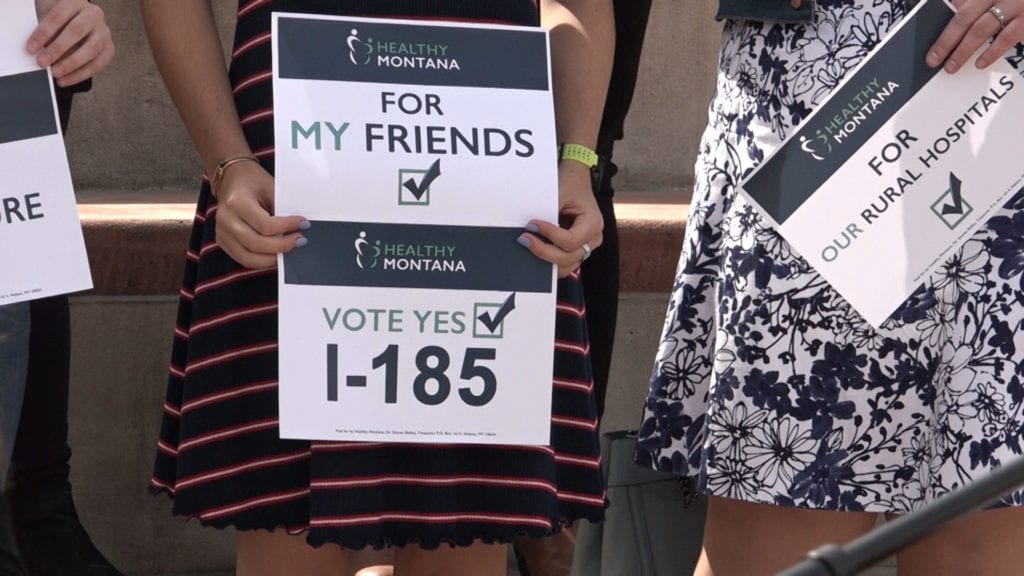This is the second of a three-part series on MTN-MSU’s post-election poll
BOZEMAN – Republican voters largely came down against the top two ballot measures on Montana’s 2018 ballot, leading to their defeat, an MTN News-Montana State University post-election poll shows.
The poll showed that almost 80% of self-identified Republican voters, who make up the largest voting bloc in Montana, opposed Initiative 185, which would have extended Medicaid expansion and raised tobacco taxes, and Initiative 186, which proposed water-treatment requirements for new hard-rock mines.
Nearly an identical percentage of Democratic voters supported the two measures, but Democrats are a smaller bloc of Montana voters – and Independents, about a third of the electorate, didn’t make up the difference, poll results showed.
According to the poll, Independent voters split on I-185, at 50-50, and they opposed I-186 by a margin of 54%-to-46%.
Montana voters defeated I-185 in the November 6 election, with 53% opposed, and also voted down I-186, with 56% voting “no.”

The poll also showed that the referendum on the 6-Mill Levy, which helps fund the state university system, passed despite opposition from a majority of Republican voters. It had strong support from Democrats and Independents.
MSU political scientist David Parker, who helped design and conduct the poll, said the substantial amount of money spent on the I-185 and I-186 campaigns helped polarize voters into partisan camps.
“What happened (on I-185) is Democrats moved to the `yes’ column because it became about health care and Medicaid,” he said. “And Republicans and Independents overwhelmingly moved to the `no’ column, I think, because of the issues about taxes.”
I-185 proposed increasing taxes by $2 for a pack of cigarettes and by 67 percent on other tobacco products, to help pay the state costs of Medicaid expansion, which provides health coverage to 95,000 low-income Montana adults.
Two national tobacco companies spent more than $17 million on the campaign against I-185, framing it as a tax increase that wouldn’t even cover the full state cost of Medicaid expansion.
On I-186, the mining industry spent about $5 million to defeat it. The industry campaign said the measure would effectively shut down future mines by saying no mine cleanup plan could have perpetual treatment of contaminated water.
Parker said on I-186, undecided voters and Independents apparently broke strongly toward voting “no.” That movement, coupled with opposition from most Republicans, meant a decisive defeat for the measure, he said.
“What did happen in this case is those undecided voters overwhelmingly broke on the `no’ position, and that’s what we would normally expect,” Parker said. “That’s the status quo position.”
Poll results are based on responses from 1,424 Montanans who replied to questionnaires mailed the day after the November 6 election. The questionnaires were sent to the 2,000 people who responded to MTN-MSU’s pre-election poll in late September and early October.
The results of the post-election poll have a margin of error plus-or-minus 2.6%t.
The poll asked Montanans a variety of questions about how and why they voted in the 2018 elections and where they stand on key issues facing the state.
Results from the poll questions on I-185 and I-186 include:
- On I-185, an identical 79% of self-identified Republicans voted against it and 79% of Democrats voted for it. Independents split 50-50.
- On I-186, 78% of Republican voters voted “no” while 77% of Democrats voted “yes.” Among Independents, 54% voted against it and 46% supported it.
- Male voters overwhelmingly voted against both measures, by 61%-to-39% margin on each initiative.
- Women voters supported I-185, the Medicaid initiative, by 53%-to-47% margin, and were split 50-50 on I-186. However, on both measures, married women were more likely to vote against them.
- Single women favored I-185 by 58%-to-42% and married women split on the measure, 50-50. On the mining initiative, I-186, single women strongly favored it by 61%-to-39%, while married women were opposed, 58%-to-42%.
- Those with four years or more of college education supported both measures, by strong margins.
- Voters with a high school diploma or less education strongly opposed I-186, the mining measure. On I-185, voters with a high school diploma opposed it, by 59%-to-41%, but voters with less than a high school education supported it, by 55%-to-45%.
- On the 6-Mill Levy, which was on the ballot as Legislative Referendum 128, Democrats, Independents and women voters came out in support, by wide margins.
- 89% of self-identified Democrats voted “yes,” 68% of Independents voted in favor, and 71% of female voters did as well.
- Those strong reservoirs of support were enough to offset opposition from 55% of self-identified Republican voters. The measure passed with 63% of Montana voters in favor.
Next: Approval ratings on top elected officials in Montana and voters’ views on key issues.

